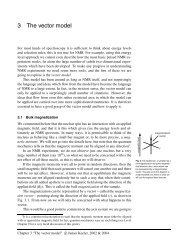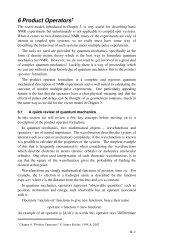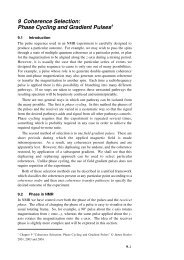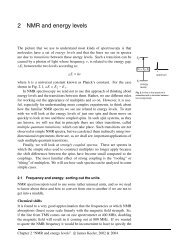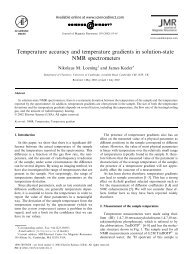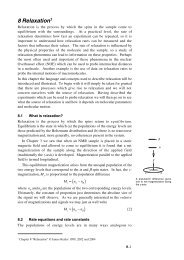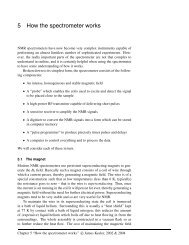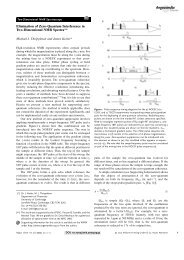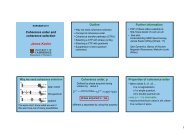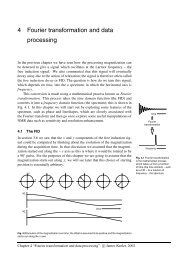Phase Cycling and Gradient Pulses - The James Keeler Group
Phase Cycling and Gradient Pulses - The James Keeler Group
Phase Cycling and Gradient Pulses - The James Keeler Group
Create successful ePaper yourself
Turn your PDF publications into a flip-book with our unique Google optimized e-Paper software.
absorption mode spectrum. We must also ensure that the two spectra we are<br />
comparing have the same limiting resolution in the t 1<br />
dimension, that is they<br />
achieve the same maximum value of t 1<br />
<strong>and</strong>, of course, the total experiment time<br />
must be the same.<br />
<strong>The</strong> detailed argument which is needed to analyse this problem is beyond the<br />
scope of this lecture; it is given in detail in J. Magn. Reson Ser. A, 111, 70-76<br />
(1994) † . <strong>The</strong> conclusion is that the signal-to-noise ratio of an absorption mode<br />
spectrum generated by recombining P- <strong>and</strong> N-type gradient selected spectra is<br />
lower, by a factor 1 2 , than the corresponding phase cycled spectrum with<br />
SHR or TPPI data processing.<br />
<strong>The</strong> potential reduction in sensitivity which results from selection with<br />
gradients may be more than compensated for by an improvement in the quality<br />
of the spectra obtained in this way. Often, the factor which limits whether or<br />
not a cross peak can be seen is not the thermal noise level by the presence of<br />
other kinds of "noise" associated with imperfect cancellation etc.<br />
180°<br />
δ δ<br />
RF<br />
∆<br />
g τ τ<br />
9.6.6 Diffusion<br />
<strong>The</strong> process of refocusing a coherence which has been dephased by a gradient<br />
pulse is inhibited if the spins move either during or between the defocusing <strong>and</strong><br />
refocusing gradients. Such movement alters the magnetic field experienced by<br />
the spins so that the phase acquired during the refocusing gradient is not exactly<br />
opposite to that acquired during the defocusing gradient.<br />
In liquids there is a translational diffusion of both solute <strong>and</strong> solvent which<br />
causes such movement at a rate which is fast enough to cause significant effects<br />
on NMR experiments using gradient pulses. As diffusion is a r<strong>and</strong>om process<br />
we expect to see a smooth attenuation of the intensity of the refocused signal as<br />
the diffusion contribution increases. <strong>The</strong>se effects have been known <strong>and</strong><br />
exploited to measure diffusion constants since the very earliest days of NMR.<br />
<strong>The</strong> effect of diffusion on the signal intensity from the simple echo sequence<br />
shown opposite is relatively simple to analyse <strong>and</strong> captures all of the essential<br />
points. Note that the two gradient pulses can be placed anywhere in the<br />
intervals δ either side of the 180° pulse. For a single uncoupled resonance, the<br />
intensity of the observed signal, S, expressed as a fraction of the signal intensity<br />
in the absence of a gradient, S 0<br />
is given by<br />
S ⎛ 2 2 2<br />
= − G<br />
⎛ τ<br />
−<br />
⎞ ⎞<br />
exp⎜<br />
γ τ ∆ D<br />
S ⎝ ⎝<br />
0<br />
3⎠<br />
⎟<br />
[15]<br />
⎠<br />
where D is the diffusion constant, ∆ is the time between the start of the two<br />
gradient pulses <strong>and</strong> τ is the duration of the gradient pulses; relaxation has been<br />
ignored. For a given pair of gradient pulses it is diffusion during the interval<br />
between the two pulses, ∆, which determines the attenuation of the echo. <strong>The</strong><br />
†<br />
<strong>The</strong>re is an error in this paper: in Fig. 1(b) the penultimate S spin 90° pulse should be phase y<br />
<strong>and</strong> the final S spin 90° pulse is not required.<br />
9–42



